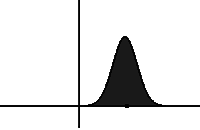 | ||
In statistical mechanics, the Fokker–Planck equation is a partial differential equation that describes the time evolution of the probability density function of the velocity of a particle under the influence of drag forces and random forces, as in Brownian motion. The equation can be generalized to other observables as well. It is named after Adriaan Fokker and Max Planck and is also known as the Kolmogorov forward equation, after Andrey Kolmogorov, who independently discovered the concept in 1931. When applied to particle position distributions, it is better known as the Smoluchowski equation (after Marian Smoluchowski). The case with zero diffusion is known in statistical mechanics as the Liouville equation.
Contents
- One dimension
- Many dimensions
- Wiener process
- OrnsteinUhlenbeck process
- Plasma physics
- Computational considerations
- Solution
- Particular cases with known solution and inversion
- FokkerPlanck equation and path integral
- References
The first consistent microscopic derivation of the Fokker–Planck equation in the single scheme of classical and quantum mechanics was performed by Nikolay Bogoliubov and Nikolay Krylov.
The Smoluchowski equation is the Fokker–Planck equation for the probability density function of the particle positions of Brownian particles.
One dimension
In one spatial dimension x, for an Itō process driven by the standard Wiener process
with drift
While the Fokker–Planck equation is used with problems where the initial distribution is known, if the problem is to know the distribution at previous times, the Feynman-Kac formula can be used, which is a consequence of the Kolmogorov backward equation.
The stochastic process defined above in the Itō sense can be rewritten within the Stratonovich convention as a Stratonovich SDE:
It includes an added noise-induced drift term due to diffusion gradient effects if the noise is state-dependent. This convention is more often used in physical applications. Indeed, it is well known that any solution to the Stratonovich SDE is a solution to the Itō SDE.
The zero drift equation with constant diffusion can be considered as a model of classical Brownian motion:
This model has discrete spectrum of solutions if the condition of fixed boundaries is added for
It has been shown that in this case an analytical spectrum of solutions allows deriving a local uncertainty relation for the coordinate-velocity phase volume:
Here
Many dimensions
More generally, if
where
with drift vector
If instead of an Itō SDE, a Stratonovich SDE is considered,
the Fokker–Planck equation will read ( pag. 129):
Wiener process
A standard scalar Wiener process is generated by the stochastic differential equation
Here the drift term is zero and the diffusion coefficient is 1. Thus the corresponding Fokker–Planck equation is
which is the simplest form of a diffusion equation. If the initial condition is
Ornstein–Uhlenbeck process
The Ornstein–Uhlenbeck process is a process defined as
with
The stationary solution (
Plasma physics
In plasma physics, the distribution function for a particle species
where the third term includes the particle acceleration due to the Lorentz force and the Fokker–Planck term at the right-hand side represents the effects of particle collisions. The quantities
Computational considerations
Brownian motion follows the Langevin equation, which can be solved for many different stochastic forcings with results being averaged (the Monte Carlo method, canonical ensemble in molecular dynamics). However, instead of this computationally intensive approach, one can use the Fokker–Planck equation and consider the probability
Solution
Being a partial differential equation, the Fokker–Planck equation can be solved analytically only in special cases. A formal analogy of the Fokker–Planck equation with the Schrödinger equation allows the use of advanced operator techniques known from quantum mechanics for its solution in a number of cases. In many applications, one is only interested in the steady-state probability distribution
Particular cases with known solution and inversion
In mathematical finance for volatility smile modeling of options via local volatility, one has the problem of deriving a diffusion coefficient
Fokker–Planck equation and path integral
Every Fokker–Planck equation is equivalent to a path integral. The path integral formulation is an excellent starting point for the application of field theory methods. This is used, for instance, in critical dynamics.
A derivation of the path integral is possible in the same way as in quantum mechanics, simply because the Fokker–Planck equation is formally equivalent to the Schrödinger equation. Here are the steps for a Fokker–Planck equation with one variable x. Write the FP equation in the form
The x-derivatives here only act on the
Insert the Fourier integral
for the
This equation expresses
The variables
Although formally equivalent, different problems may be solved more easily in the Fokker–Planck equation or the path integral formulation. The equilibrium distribution for instance may be obtained more directly from the Fokker–Planck equation.
